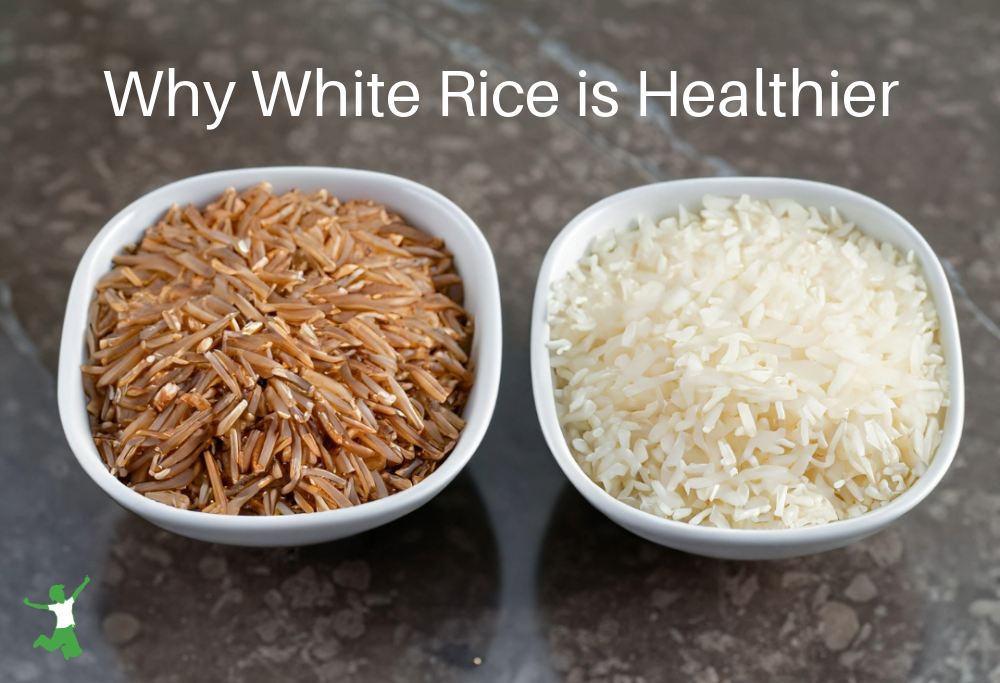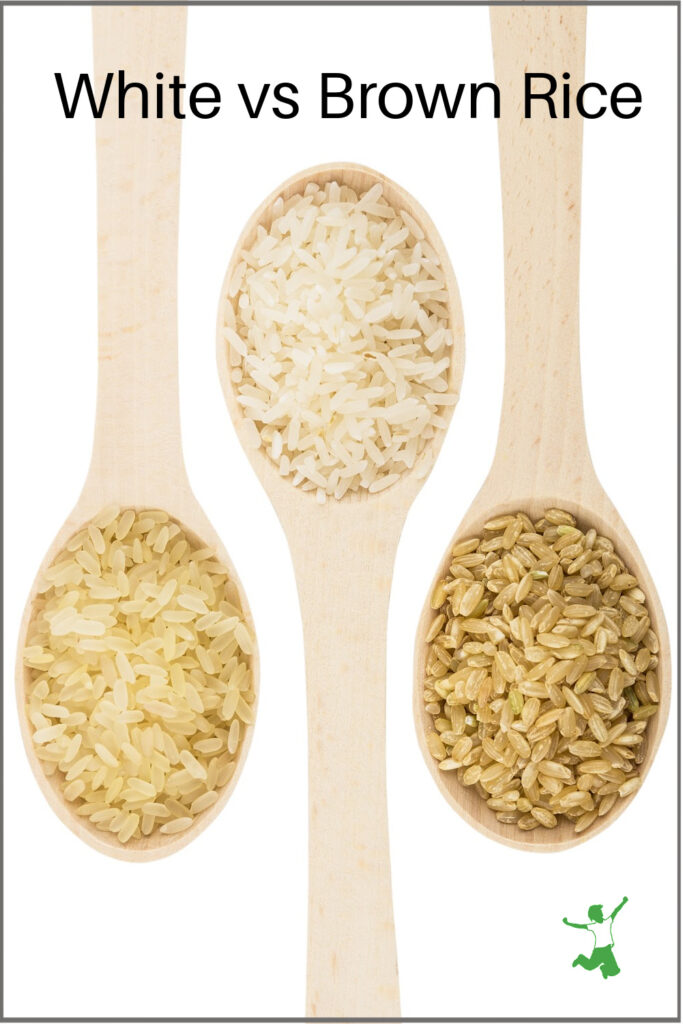The reasons white rice is healthier than brown rice as determined by research as well as which type traditional societies preferred consuming.

My article and video on healthy Chinese food drew some comments from readers who questioned my choice of rice.
Why was I using white rice vs brown? Isn’t brown rice the healthier choice, after all?
Ok, I’ll spill the beans, rice. Here are my reasons …
The truth is, neither my husband nor myself have ever enjoyed brown rice (although we love the nutty flavor and digestibility of wild rice).
Every time we eat brown, it just seems to not sit very well in our stomachs.
Even when it is sprouted or soaked before cooking, it, well, uh, sits like a brick for lack of a better word.
Why Some People Should Eat White Rice
White rice just seems to digest a whole lot better for us. That to me was reason enough to choose it over the brown rice.
We were also advised by an Ayurvedic MD back in the 1990s to stick with white basmati rice. This recommendation clinched the decision.
You are what you digest, after all – not necessarily what you eat!
End of story? Well, not quite.
Rice Fiber in Brown Harms a Compromised Gut
A few years back at the annual Wise Traditions Conference, I became familiar with a compelling book called Fiber Menace.
The author writes extensively about the dangers of a high-fiber diet as it pertains to a menu loaded with whole grains as pushed by the misguided Food Pyramid.
In other words, folks who eat a bowl of All Bran every morning to keep the bathroom visits regular are unknowingly ripping their insides to shreds.
The basic premise of Fiber Menace is that grain fiber plays a leading role in many gut-related ailments including colon cancer.
When I first learned of this information, my preference for white rice over brown rice started to make more sense.
Perhaps the brown rice didn’t digest that well because of all that fiber?
Chalk one up for the white rice.
White Rice Far Lower in Phytic Acid
A second piece of information came from author Ramiel Nagel.
In his book, Cure Tooth Decay, he writes about the devastating effects of phytic acid in the diet. Phytic acid is a very powerful antinutrient and blocker of mineral absorption in the gut.
Mr. Nagel identifies brown rice as very high in phytic acid.
What’s more, soaking brown rice does not reduce phytic acid by much at all!
Polished Rice is the Ancestral Form
Ramiel also maintains that the traditional method for preparing brown rice is never to eat it whole (with only the husk removed).
Rather, ancestral societies pounded brown rice in a mortar and pestle to polish it by removing the outer bran layer. This is the primary source of the phytic acid.
Nagel goes on to point out that experiments have shown that the milled and polished rice that results from this pounding process, has the highest mineral absorption.
In short, mineral absorption from whole brown rice is much less than white polished rice. This is because the phytic acid in the bran which is not reduced much by soaking, greatly interferes with the absorption process.
What About Arsenic?
A big issue with arsenic contamination in rice has emerged in recent years. Some folks have responded by no longer eating rice at all.
This is an overreaction, in my view.
Clean rice is definitely available if you know what to look for.
This article on how to avoid arsenic in rice details what to do. While soaking brown rice barely moves the needle on phytic acid, soaking white rice before cooking removes nearly all the arsenic!
Another option is to parboil white rice before using fresh water for a full cook if you don’t have time to soak.
Is White Rice Better Than Brown?
So it seems that brown rice is not necessarily a healthier choice than milled white rice.
Black or red rice would fall into the same category.
Obviously, whether you choose one or the other is a personal preference, but I hope this information helps you sort through the decision with a bit more clarity.
As for me and my family, we will be sticking with white basmati and jasmine rice (white basmati rice is more nutritious than plain white rice).
I currently buy this brand of rice in 25-pound bags as the most economical and high-quality choice.
Observation clued me in many years ago that brown rice was not something that was sitting well in my stomach or my husband’s.
As the years go by, more research is coming forth to indicate that this decision was the right way to go after all.
Do you eat white rice or brown rice in your home? Why or why not?

References
(1) Fiber Menace
(2) Living with Phytic Acid
More Information
Macrobiotic Diet and Extreme Vitamin D Deficiency
Tiny Teff Grains Deliver Big on Nutrition
How to Make Perfect Yellow Rice (Arroz Amarillo)
Millet: Healthy or Not?
Do Whole Grains Cause Cavities?







I've come to a similar conclusion and no longer feel guilty about choosing white rice over brown. I became convinced after reading the book "Japanese Women Don't Get Old Or Fat".
I serve white rice with TONS of grass fed butter melting on top. 🙂
I probably should have added that I don't eat the brown rice(that I thought was healthier) very often because…drumroll please…it doesn't sit well with me.
I may be showing my ignorance here, but I have never used white because I thought it was bleached. Most grains are not that white naturally.
Hey Sarah:) It's been a while!
Hey Erin,
I just wanted to say that as far as I know, the white rice imported from Asia is naturally that white. I’ve seen that rice in every stage of it’s production.. the only bleaching it gets is from the sun when they spread it out to dry. Also, no-one I met in the Philippines had ever even heard of brown rice!
Cheers!
I have a bag of brown rice in the pantry that has been there for who knows how long! I think I will finally throw it away. My family has never liked brown rice… I'll stick with my jasmine rice! We love it in jambalaya 🙂
I haven't soaked white basmati rice before. I'll bet it does improve the end product, though. How long does she soak it for and does she soak it in plain filtered water? I will have to try it next time I make it.
I’ve been soaking my white basmati rice like Nourishing Traditions would soak brown, up to 7 hours in water and a little whey. Then I drain it, rinse it and cook it the usual way, but generally in some broth or stock. It’s wonderful! I figure the soaking has to help digest it even more, right? Maybe it’s an extra step I don’t need to take, but sounds like a good idea.
It is seven months since I first read this about white vs brown rice and I have not gone back to brown yet, but do see that WAPF and NT recipes still seem to prefer and suggest brown over white. Have they not read Fiber Menace? On the soaking, I was in Turkey last summer, talk about fabulous food! and when I got back home bought a Turkish cookbook because that food totally hit a chord with me and they use of course, white basmati rice but they not only soak it first, but then continue to rinse, soak for a few minutes, rinse again and continue with this process until the rice water is no longer milky, but clear. Then they let it air dry before sauté ing it in ghee before adding the stock to it. Rice pilaf and all it’s variations from this cookbook are so very good and according to your article here, much more nutritious.
I found that soaking white basmati rice improves digestion and taste! I only soak in distilled water. I’m amazed how important the type of water used is at achieving the best results from soaked grains. I have big issues with beans and lentils, even soaked. I decided to soak in distilled water with vinegar rather than filtered water. I had NO gas or bloating AT ALL. i was so amazed.
Sarah-do you soak the white rice? I remember my pastor's wife (who is from S. Korea) said that the best way to make rice was to soak it and then rinse it thoroughly, which is how she made her white rice in Korea.
Hey folks .. there are couple comments that haven't come through yet for some reason. Probably a Google glitch. Hopefully, all should be caught up soon.
Our family is crazy for jasmine rice! Glad to know it's not a bad option. We don't often have rice, but this gives me an idea for supper tonight….
Heidi
Thanks for posting! I hadn't heard any of that yet! As we just went grain free it doesn't effect our family so much but I will definitely mention it to my Mom! Thanks!
.ambre. latest post:Pizza With A Grain Free Twist
Hmm…might need to try out the white rice again. I know we've seemed to have minor issues with brown — not enough to have switched yet. We were actually told we were allergic to it at one point (by an acupuncturist/nutritionist via muscle testing). So this is all good to know.